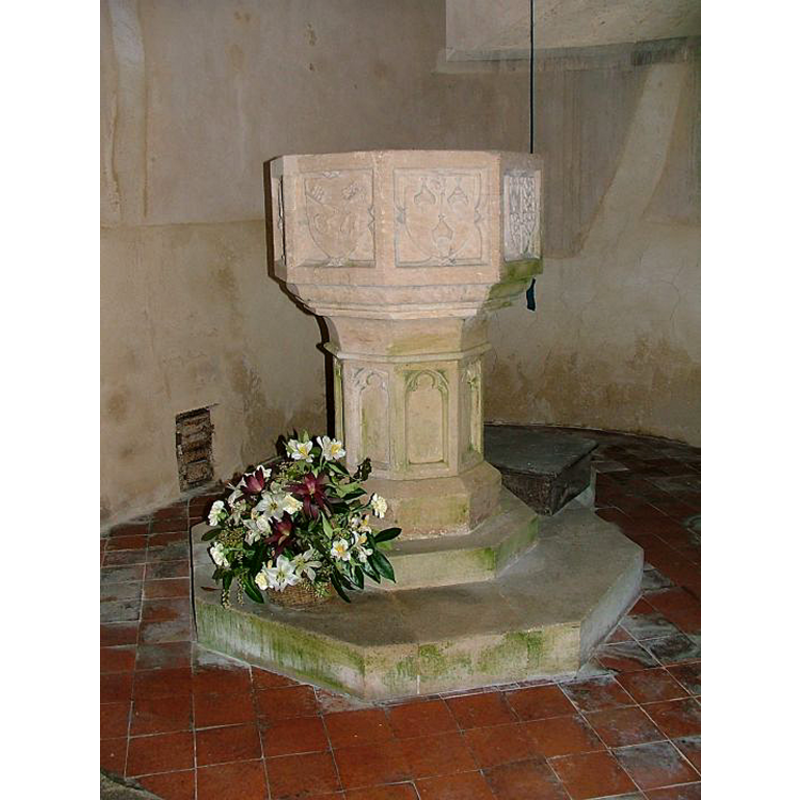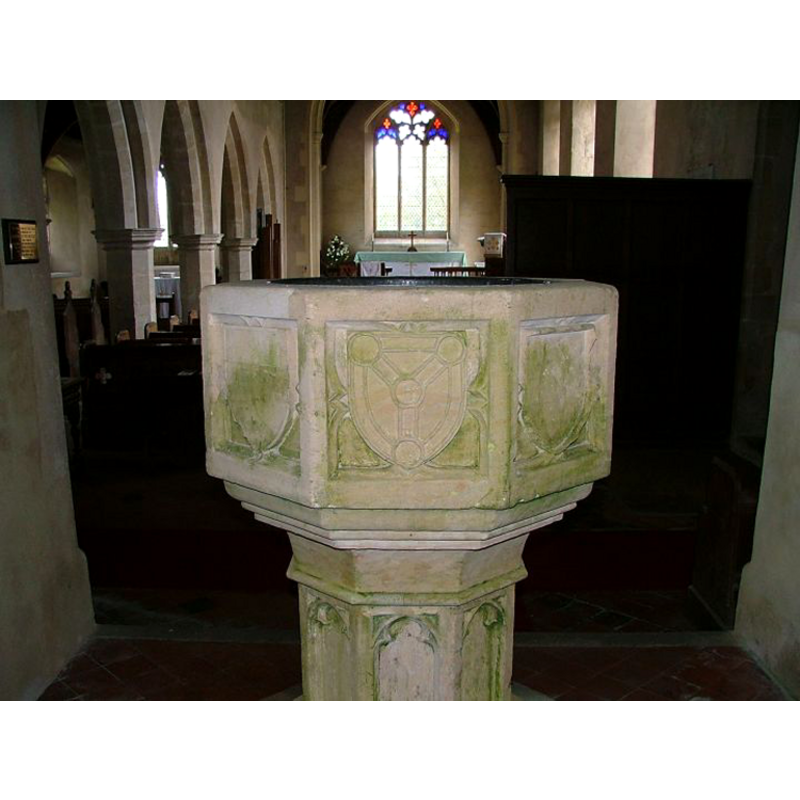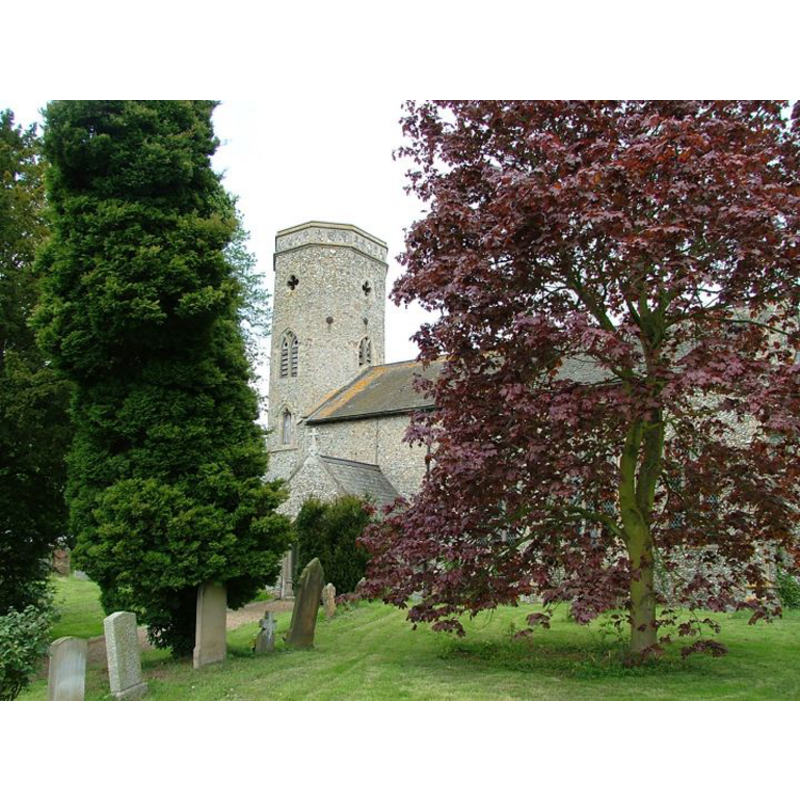Kettlestone / Katestuna / Ketestuna / Kettleston / Kettlestuna

Image copyright © Simon Knott, 2005
Standing permission
Results: 13 records
B01: coat of arms
B04: symbol - shield - emblem - Christ - the instruments of the Passion?
LB01: design element - architectural - arcade - blind - trefoiled arches - 8
LB02: design element - motifs - moulding
view of basin - west side
view of church exterior
INFORMATION
FontID: 11518KET
Object Type: Baptismal Font1
Church/Chapel: Parish Church of All Saints
Church Patron Saints: All Saints
Church Location: 100 The Street, Kettlestone, Norfolk NR21 0AU
Country Name: England
Location: Norfolk, East Anglia
Directions to Site: Located on the E side of the A148, right across from Little Snoring, just NE of Fakenham
Ecclesiastic Region: Diocese of Norwich
Historical Region: Hundreds of Gallow and Brothercross
Font Location in Church: Inside the church, in the W end
Century and Period: 15th century, Perpendicular
Workshop/Group/Artisan: heraldic font
Credit and Acknowledgements: We are grateful to Simon Knott, of www.suffolkchurches.co.uk, for the information on and photograph of this font and church.
Font Notes:
Click to view
Blomefield (1805-1810) cites the content of one of Domesday entries for 'Kettlestuna', "a church, with 8 acres" reported in it, and adds: "The Church is dedicated to All-Saints, a rectory", with John of Arderne as its first recorded rector. A font is not mentioned in this source. Gough (1792) notes that the font "at Kettlestone is adorned with the arms of France and England quarterly, and others."Shields on the Font. V. Two keys in saltire, St. Peter. -- VI. Three mitres, two and one; in pale a crosier. See of Norwich. VII. Qoarterly : — 1 and 4, lyanee (modem) ; 2 and 3, England. -- VIII. Plain. -- IX. Emblem of the Trinity. -- X. Plain. -- XI. A cross. -- XII. Two swords in saltire, St. Paul." Described in Pevsner & Wilson (1997) as having "the symbol of the Trinity, a cross, the crossed swords, the crossed keys, the arms of Norwich (three mitres), and the arms of England quartering France". Knott (2005) writes: "The font is good, a heraldic affair from the very eve of the Reformation". The font consists of an octagonal basin with wertical sides decorated with a charged shield in each side; the underbowl has a graded chamfer followed down by a concave unadorned section that ends in a thin moulding at the start of the stem; the latter is also octagonal, each panel adorned with a blank trefoil arch or window; the lower base is octagonal and plain, with two volumes; plain octagonal plinth with kneeling stone. [NB: we have no information on the font from the early church here].
COORDINATES
Church Latitude & Longitude DMS: 52° 50′ 49.62″ N, 0° 55′ 12.87″ E
MEDIUM AND MEASUREMENTS
Material: stone
Font Shape: octagonal (mounted)
Basin Interior Shape: round
Basin Exterior Shape: octagonal
REFERENCES
Blomefield, Francis, An essay towards a topographical history of Norfolk, 1805-1810
Farrer, Edmund, The Church Heraldry of Norfolk, a description of all coats of arms […] now to be found in the county […], Norwich: A.H. Goose and Co., 1885-1893
Gough, Richard, "Description of the old font in the Church of East Meon, Hampshire, 1789: with some observations on fonts", X, Archaeologia, 1792, pp. 183-209; p. 193
Knott, Simon, The Norfolk Churches Site, Simon Knott, 2004. [standing permission to reproduce images received from Simon (February 2005]. Accessed: 2006-02-24 00:00:00. URL: www.norfolkchurches.co.uk.
Pevsner, Nikolaus, Norfolk 1: Norwich and North-East [2nd ed.], Harmondsworth: Penguin Books, 1997
![[cf. Font notes]](/static-50478a99ec6f36a15d6234548c59f63da52304e5/compressed/1060224008_compressed.png)
![[cf. Font notes]](/static-50478a99ec6f36a15d6234548c59f63da52304e5/others/image_not_available.jpg)
![[cf. Font notes]](/static-50478a99ec6f36a15d6234548c59f63da52304e5/bsi-testing-site/others/image_not_available.jpg)

